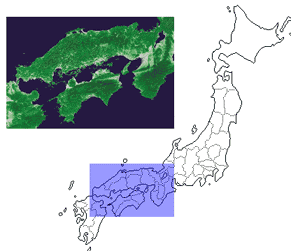

In 1949, eight Regional National Fisheries Research Laboratories were established in the respective areas in Japan to reinforce research activities of fisheries under a serious food shortage after the World War II. One of them, Naikai Regional Fisheries Research Laboratory with responsibility for the Seto Inland Sea is the first predecessor of the present National Research Institute of Fisheries and Environment of Inland Sea, Fisheries Research Agency. In the second half of twentieth century, our Institute was temporarily renamed as "Nansei Regional Fisheries Research Laboratory, (1967-1989)" and "Nansei National Fisheries Research Institute, (1989-1998)" and was also in charge of the Southern District of the Pacific Coast. The present National Research Institute of Fisheries and Environment of Inland Sea, renamed in 1998, is not responsible for the Southern District of the Pacific Coast. In 2001, the Japanese government did large-scale reorganization. With it, our Institute became subordinate one of Fisheries Research Agency separated from Ministry of Agriculture, Forestry and Fisheries.
 The Seto Inland Sea is the biggest inland sea in Japan and the total area is about 22,000 km2 which is nearly the same as that of Lake Ontario in North America. About 34 million peoples live in the coastal area of the Seto Inland Sea, and the industrial production holds 30% of the whole country. The Seto Inland Sea is shallow and has many rivers flowing into it. It produces an abundance of marine organisms, with commercial catches of 35 to 40 t per km2, which is several times greater than for other coastal fishing areas. Advanced fishing techniques and marine fishing farms boost the yield from this area. Fishery production of 1999 in the Seto Inland Sea was about 580,000 tons and occupied 20% of the total production of Japanese coastal fisheries. However, reclamation of coastal zones, pollution and eutrophication of coastal waters associated with the development of industries and human activities are becoming increasing obstacles for management of fishing and aquaculture in the Seto Inland Sea. For example, the decrease of the important fishery resources such as anchovy or spanish mackerel is worried and the fishery damage by red tide often occurs. Therefore, research and development for the promotion of desirable fisheries and of marine environment conservation at coastal zone are required earnestly. Various kind of research activities have been carried out in our laboratories and field works for understanding coastal marine ecosystem and environmental problems in the Seto Inland Sea as well as in other coastal areas in Japan.
The Seto Inland Sea is the biggest inland sea in Japan and the total area is about 22,000 km2 which is nearly the same as that of Lake Ontario in North America. About 34 million peoples live in the coastal area of the Seto Inland Sea, and the industrial production holds 30% of the whole country. The Seto Inland Sea is shallow and has many rivers flowing into it. It produces an abundance of marine organisms, with commercial catches of 35 to 40 t per km2, which is several times greater than for other coastal fishing areas. Advanced fishing techniques and marine fishing farms boost the yield from this area. Fishery production of 1999 in the Seto Inland Sea was about 580,000 tons and occupied 20% of the total production of Japanese coastal fisheries. However, reclamation of coastal zones, pollution and eutrophication of coastal waters associated with the development of industries and human activities are becoming increasing obstacles for management of fishing and aquaculture in the Seto Inland Sea. For example, the decrease of the important fishery resources such as anchovy or spanish mackerel is worried and the fishery damage by red tide often occurs. Therefore, research and development for the promotion of desirable fisheries and of marine environment conservation at coastal zone are required earnestly. Various kind of research activities have been carried out in our laboratories and field works for understanding coastal marine ecosystem and environmental problems in the Seto Inland Sea as well as in other coastal areas in Japan.